🎥 Video: 3 Use Cases to Increase Football Club Revenue with Gamification.
Save your seat.
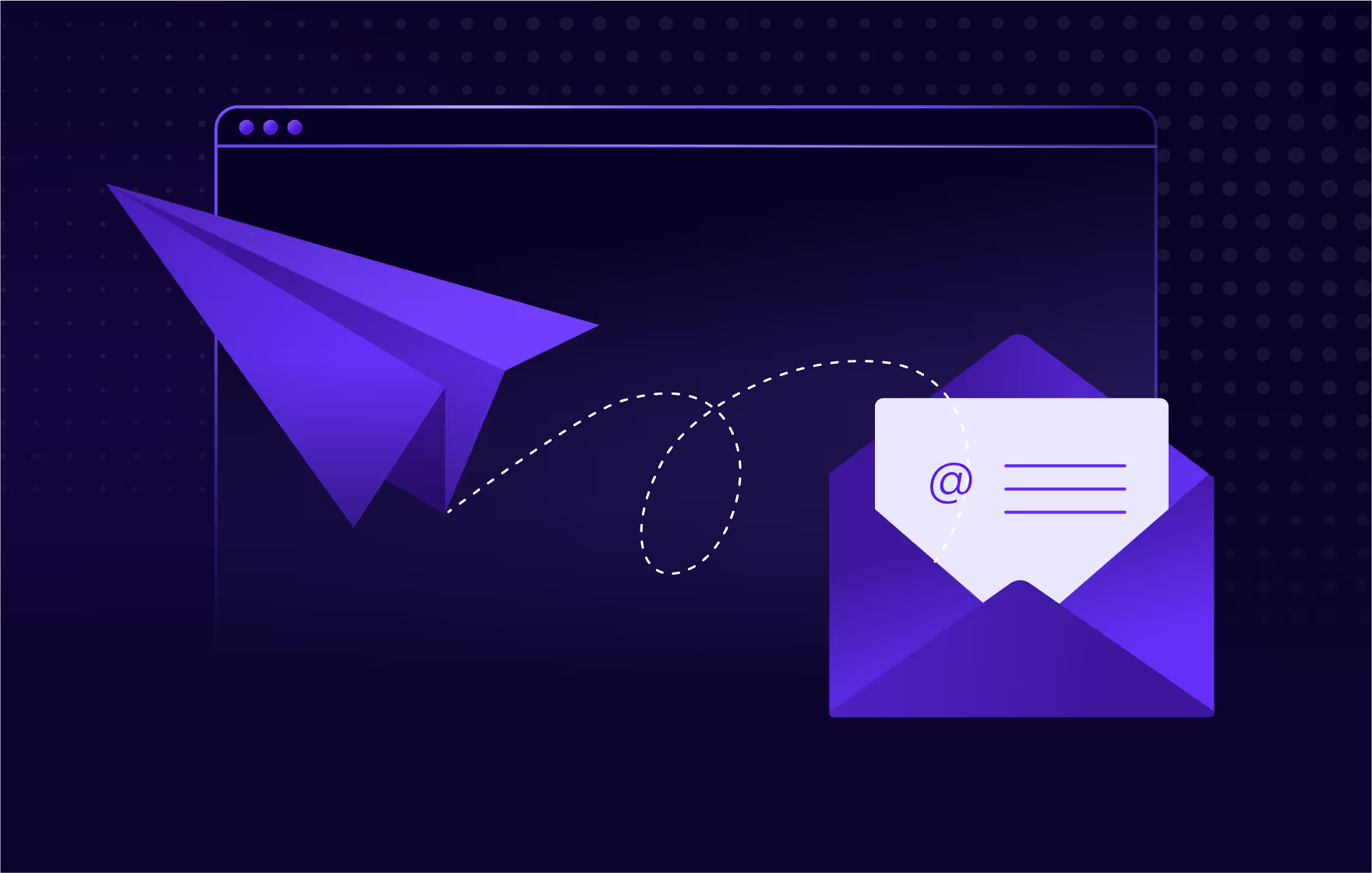

Loyalty programs are a proven way to boost customer retention and lifetime value. Email is a key channel for engaging loyal customers.
Indeed, over 80% of loyalty campaigns utilize email to keep members engaged and active. The right email, sent at the right time, can reward members, remind them of perks, and motivate repeat purchases.
Below, we present seven loyalty program email examples (with real copy snippets) for different situations. For each, we explain the business objective and strategic purpose, and share best practices for implementation.
We also highlight how Open Loyalty's API-driven platform, featuring customizable points wallets, tier systems, and gamification mechanics, can help automate and optimize these campaigns.
🧠 Stay up to date with every trend, even those related to email marketing strategies. See where loyalty programs are heading next year. The latest Loyalty Program Trends report breaks down global data, expert insights, and real examples that show how brands keep members engaged.
A loyalty program email is a message sent to members of a rewards program to keep them engaged, informed, and motivated to take the next step. Instead of generic promotions, these emails are tied to the customer's journey inside the program.
Some examples include:
The goal is simple: make customers feel recognized while nudging them toward repeat purchases and deeper program participation. When designed well, loyalty program emails act as reminders of exclusive rewards, unlocks, or perks, turning one-time buyers into long-term members.
This blog post will focus on communication that engages members, rather than on technical communication. However, technical updates are also a crucial form of communication since they ensure the member has proper access to the program.
Technical messages include, for example:
How to treat them? The bare minimum is to apply a consistent tone of voice and branding across all messages – whether general or technical. However, this consistency should not hinder clarity in the case of technical messages.
For example, an account deletion message can be playful and colorful if these aspects represent the brand. But it should, above all, communicate to the user what the next steps are and what the timing involved is.
Explore Open Loyalty's features like wallets, leaderboards, and gamification. Each can be tied to automated program emails that keep members active and engaged.
The welcome email is the first message a new loyalty member receives, so it should create a great first impression. Its purpose is to thank the customer for joining, introduce the program and its benefits, and set the tone for future communications.
For example:
Subject: Welcome to [Brand] Rewards! 🎉
Hello [Name],
Thank you for joining [Brand] Rewards! You've just earned 100 bonus points for signing up.
With these points, you'll unlock discounts, free gifts, and other exclusive perks. For example, 500 points = $10 off your next order. Keep earning points on every purchase and discover what rewards you can claim.
[Start earning points]
Log in anytime to track your balance and redeem rewards.
We're so glad to have you with us. Stay tuned for members-only deals and bonus opportunities!
Our example welcomes the new member by name, expresses appreciation, highlights the headline benefit (points for rewards), and includes a clear CTA (a link to view the Wallet). Best practices for a welcome email include:
Embedding Open Loyalty's features can streamline this process: for example, its campaign builder can trigger marketing automation platforms to send emails when a customer signs up, and its wallets feature lets members immediately view their bonus points.
A points balance update email is sent periodically to active members to keep them aware of their status and nudge them toward redemption.
The purpose is to remind customers of the points they've earned and encourage further engagement (especially if they're close to a reward threshold).
For example:
Subject: You have 230 points waiting! 🏆
Hi [Name],
Just a heads-up: your [Brand] loyalty account balance is 230 points (that's $11.50 toward rewards!).
You're only 20 points away from a free [Reward Item]. Every 10 points earns you $0.50 off, so you're close to unlocking something great.
[Redeem now]
See what rewards you can claim. Keep earning points to reach the next reward tier soon!
Our example clearly shows the exact points and frames them in dollar value. Key tips:
Dynamic management of point expiration dates is crucial in managing program costs and customer activation. Email reminders about approaching expiration dates serve two purposes: they drive conversions (point redemption) and simultaneously allow the program to eliminate financial obligations for remaining points in the market.
Paweł Dziadkowiec, Loyalty Expert
And an example focused on expiring points, inspiring FOMO:
Subject: Your points balance is about to expire! 🏃
Hi [Name],
Your [X points] are expiring soon — don't let them go unused! Right now, you can turn them into discounts, freebies, or other rewards waiting in your account.
Here's what you can get today:
[Example reward 1 – e.g., $5 off your next purchase]
[Example reward 2 – e.g., free shipping voucher]
[Example reward 3 – e.g., bonus item from the catalog]
It only takes a minute to redeem.
[Redeem now]
According to industry research, a points update is a good chance to show customers how close they are to redeeming their points. It informs members of their progress and encourages purchases, since people are driven by the expectation of accumulating more points.
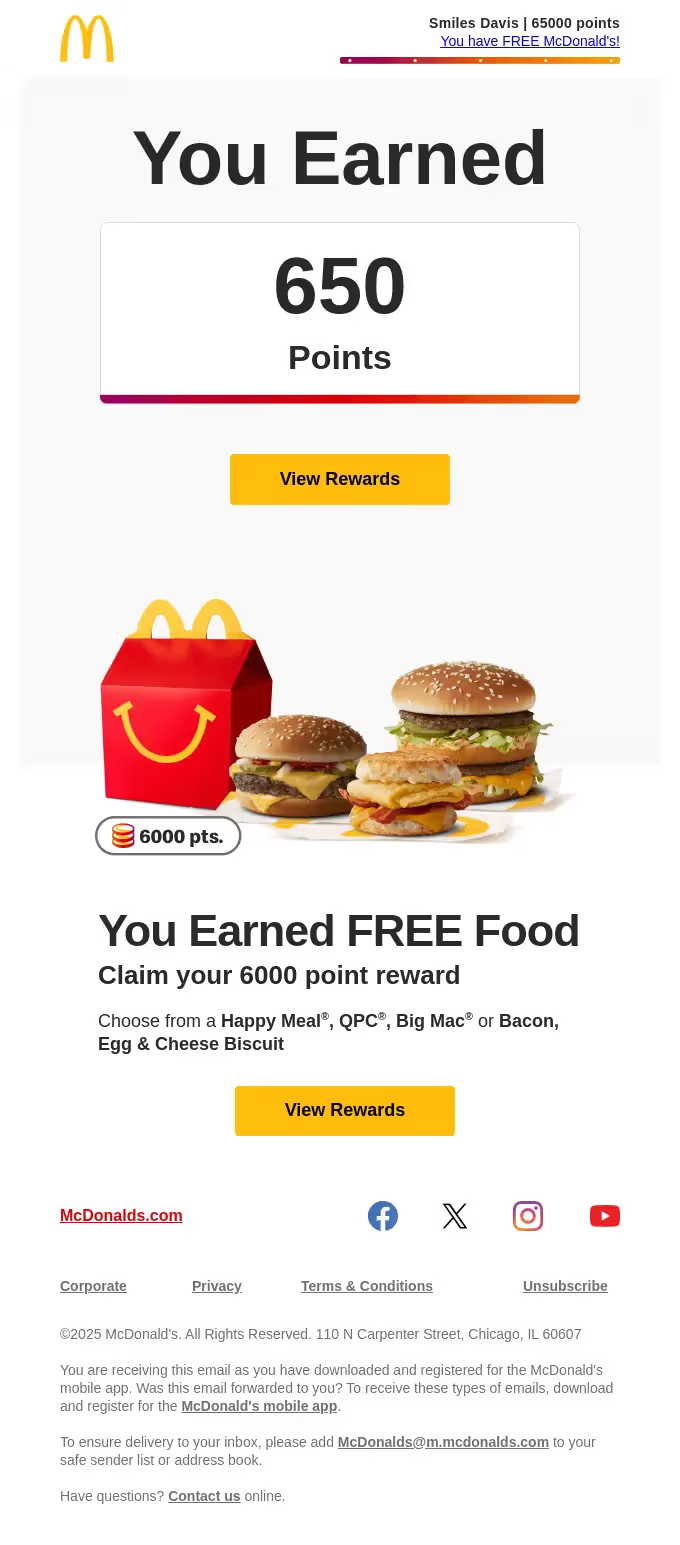
For a loyalty program to become a habit, point reports, i.e., current account balance and possibly recent transactions, must be automated and sent at regular intervals (e.g., every first Monday of the month). This builds anticipation among customers and naturally encourages them to check their status regularly.
Paweł Dziadkowiec, Loyalty Expert
Birthday or membership anniversary emails are highly personalized messages that show customers they're appreciated. The purpose is to celebrate the customer's special day (or the anniversary of joining the program) with an exclusive offer.
For example:
Subject: 🎂 Happy Birthday, [Name]! Enjoy a gift from us 🎁
Dear [Name],
Happy birthday from all of us at [Brand].
We value your loyalty, so we've added a special treat to your account: $5 bonus credit and a free [drink/dessert] to enjoy today. (That's on us!)
Redeem your birthday gift by logging into your Rewards Wallet before MM/DD.
[Claim your birthday gift]
Enjoy your celebration. Thank you for being a valued member.
Such a message uses the customer's name, offers a gift, and provides a simple redemption path. Best practices include:
The email informing the customer about the availability of a reward should avoid generalities and instead include a specific, personalized reward offer and a single, clear call-to-action button, such as "Claim your reward now," that will take them directly to the reward. The fewer steps a customer takes to redeem their reward, the higher their conversion rate.
Paweł Dziadkowiec, Loyalty Expert
A birthday email can go a long way in showing your customers that you care, and should offer them a special birthday discount/a free gift to celebrate. Sephora's example shows a personalized "Happy Birthday [Name]" line and a generous discount code for birthdays.
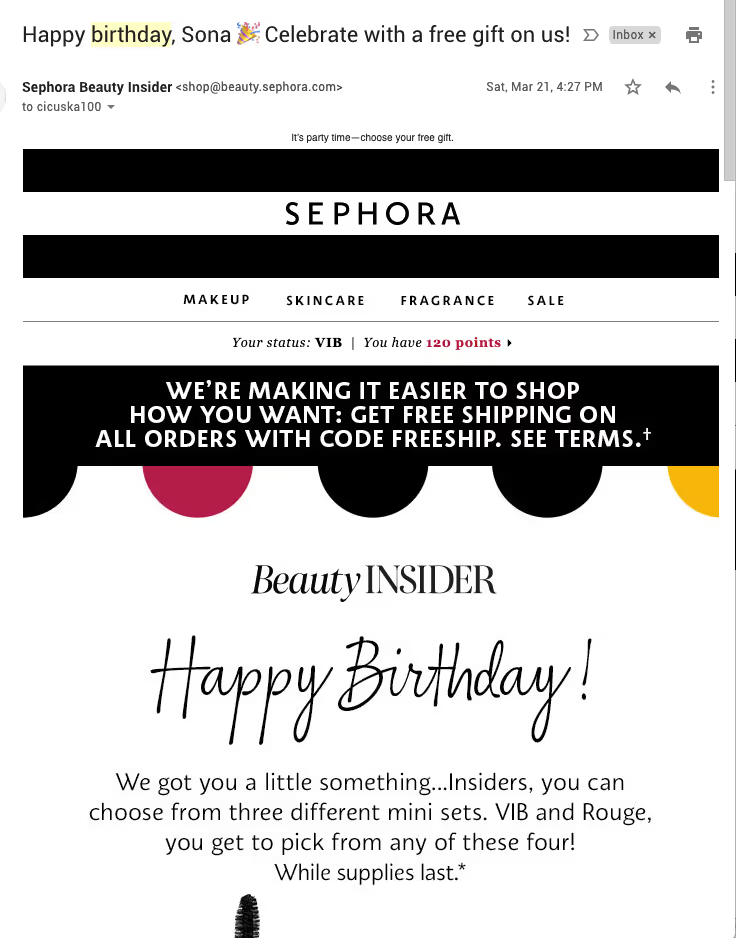
When a member reaches a new tier in a loyalty program, it's an occasion to celebrate and reinforce value. A tier upgrade email congratulates the customer on the milestone and reminds them of new benefits unlocked.
For example:
Subject: 🎉 Congrats, [Name]! You've reached Gold Member status 🎉
Hello [Name],
Great news! You've just earned Gold Tier in our rewards program.
As a Gold member, you now enjoy exclusive perks:
Your points balance is [points].
Keep up the great work because the next Silver tier is just behind you.
Learn more about Gold benefits.
In the email, the tone is celebratory. Key takeaways:
Tiered rewards are very effective. Experts note that loyalty program tiers are a powerful tool to enhance engagement, increase retention, and drive long-term allegiance. Recognizing milestone achievements with an email helps solidify that feeling of loyalty and motivates continued spending.
Tiered programs give customers something to strive for, and they work well with emails that celebrate upgrades or milestones.
The article on tiered loyalty programs explains how to structure tiers, define exclusive perks for each level, and use program emails to make members feel recognized at every step.
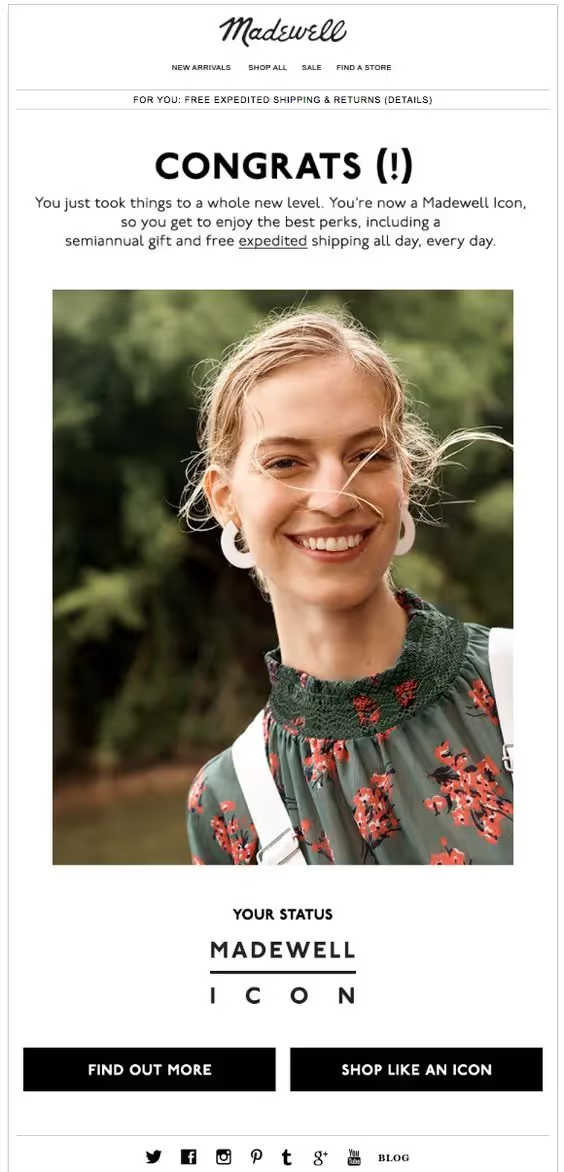
A re-engagement (win-back) email aims to bring inactive customers back. If a loyalty member hasn't shopped or used points for a while, the email reminds them what they're missing and offers an incentive to return.
For example:
Subject: We miss you! Here's a 100 bonus points welcome-back gift!
Hi [Name],
It's been a while since we've seen you…
We still have you in our [Brand] Rewards family, and we want to help you make the most of it. To welcome you back, we've added 100 bonus points to your account. It's enough for a free [reward]!
[Activate your bonus]
+ It expires in 7 days.
Log in now to claim your points and see your rewards.
In this message, a bonus offer and a reminder of newness prompt action. Best practices:
Win-back emails should show customers what they are missing and use segmentation to target lapsed members with relevant offers. A well-timed reactivation campaign reminds customers of their savings and program perks, rekindling their engagement.

Sometimes customers earn rewards or points but forget to redeem them. A redemption reminder email alerts members to expiring rewards or unused points, reinforcing program value.
For example:
Subject: Last Chance! Your 200 points expire today 🚨
Hi [Name],
Quick reminder: you have 200 loyalty points expiring tonight! Don't let them go to waste. You can redeem them for $10 off your next order. (That's like getting $10 free on us.)
[Redeem now]
It only takes a minute. Plus, as a thank-you, we're adding an extra 50 bonus points if you redeem today!
Hurry, your points disappear at midnight. We value you and don't want you to miss out!
Our example uses urgency and a bonus incentive. Best practices:
Rewards are the linchpin of customer engagement and long-term retention. Sending reminders about expiring points demonstrates you care about their benefits and can re-engage them by ensuring no earned rewards go unused.
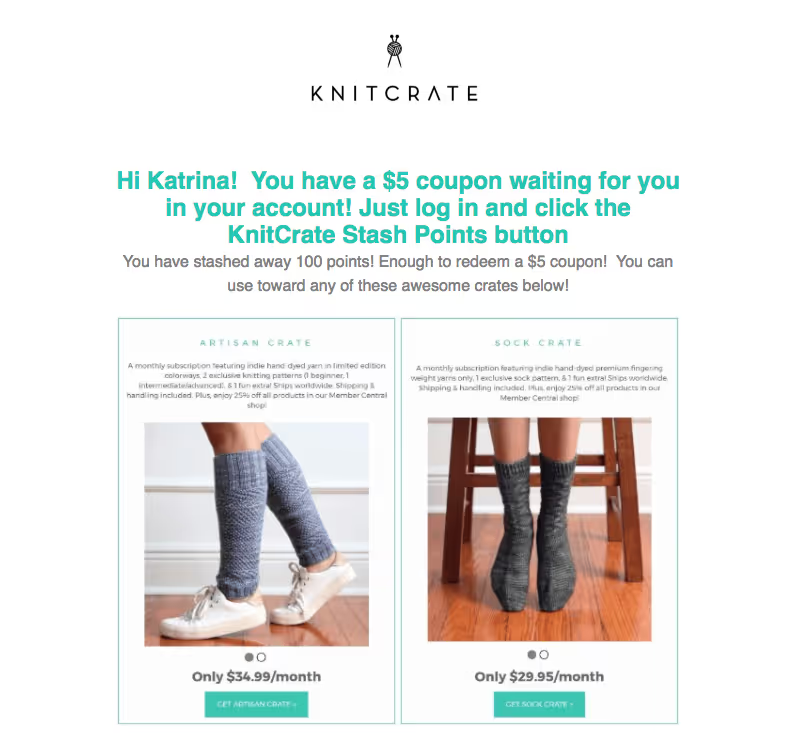
The email introduces loyalty members to a new program feature or product. For instance, a brand might launch a mobile app or a new way to earn points and needs to educate its members. The goal is to inform and drive adoption of the new feature.
For example:
Subject: 🚀 New! Earn points for referring friends (and a new mobile app)
Hello [Name],
Great news for [Brand] Rewards members! We've added a brand-new way to earn points: refer friends. Now, when you send a friend a referral link and they sign up, you both get 50 points!
In other news, our loyalty program now has a mobile app for iOS and Android. It's never been easier to track points and redeem rewards on the go.
[Download app]
To celebrate, we're giving 100 bonus points for downloading and logging in to the app this week. (That's $5 free to spend!)
Learn more.
Such a type of email should:
A well-crafted announcement keeps members informed and engaged. In our example, offering bonus points drives initial app adoption. Note that mobile loyalty programs continue to gain popularity, and customers expect loyalty via an app. Leveraging an email like this can jump-start those features.
With more customers engaging on their phones, mobile loyalty features are becoming standard. Our article highlights proven app features, like wallets, push notifications, and easy reward redemption, that can be tied into loyalty emails to keep customers connected on the go.

Loyalty program emails are designed to keep loyalty program members active and connected.
A well-timed welcome email, a points balance update, or a surprise bonus points email can remind customers of their progress and encourage them to take the next step.
Over time, these touchpoints help strengthen a customer loyalty program and keep customers engaged, leading to stronger customer retention.
A strong subject line should be short, clear, and action-driven. Use an engaging subject line or even a catchy subject line to highlight the benefit inside the message, for example, "Your 200 points are ready to use" or "Celebrate your tier upgrade today."
Subject lines that highlight exclusive perks or a chance to earn rewards often get higher opens in email marketing campaigns.
A loyalty program launch email is sent when a brand first introduces its rewards initiative. It should outline how members can earn points, redeem rewards, and enjoy exclusive rewards or exclusive benefits.
Clear call-to-action buttons and simple email examples help remind customers to join and start collecting bonus points from day one.
Every rewards program can benefit from a mix of loyalty email formats.
Popular options include a welcome email when a customer joins, a feedback request email to gather customer feedback, and a program email to announce new tiers, exclusive deals, or early access offers.
Other email examples include a customer's birthday gift message, a re-engagement note for dormant customers, or reminders to redeem points before they expire.
Every rewards program depends on a clear system for managing perks, vouchers, and point redemptions. In the loyalty rewards management guide, we outline how to design a rewards catalog, run reward campaigns, and keep program members motivated with the right balance of attainable and aspirational rewards.
A well-crafted loyalty email can directly boost customer loyalty and drive repeat purchases.
For example, messages that help members track their hard-earned points or highlight a reward for their next purchase show that customers feel valued. Programs that give out bonus points or earn rewards for referrals can turn happy buyers into loyal brand advocates who bring in new customers.
Yes. A program email aimed at dormant customers can re-engage them with offers like bonus points, exclusive perks, or updates about new features.
These emails can remind customers about their unused rewards or provide a time-limited promotion that makes them want to log back in. Strong design, for example, when you incorporate eye-catching visuals, helps the message stand out and motivates action.
Every program email plays a role in guiding members through the customer journey.
From onboarding new customers with a welcome email and nudging them with points balance updates, to offering exclusive rewards for milestones, each touchpoint helps members earn points, earn rewards, and stay part of the community. Timed campaigns also matter; for example, seasonal marketing campaigns can give program emails extra relevance during holidays or peak shopping periods.
Over time, that rhythm creates trust, helps repeat customers save money, and keeps your program strong.
Loyalty emails work best when they feel like part of an ongoing conversation rather than random promotions. A welcome note, a birthday surprise, or a points update keeps members in the loop and reminds them why the program matters to them. Over time, these touchpoints help turn occasional shoppers into repeat customers.
The examples we covered show how each type of message serves a different purpose. Some spark excitement at the very beginning, others bring lapsed members back, and some reward milestones that deserve a little celebration. When they run together as a steady rhythm, they create familiarity so that members start expecting them and reacting to them.
Running all of these campaigns can feel like a lot to manage, but it doesn't have to be complicated. Open Loyalty connects program mechanics with communication platforms so that points, tiers, and rewards flow naturally into email updates. That means your members always get the right message at the right moment, without you having to build every send from scratch.
If you're ready to put these examples into action, take the next step. Request a demo and see how Open Loyalty helps you create loyalty mechanisms that feel personal, timely, and rewarding.
Get a weekly dose of actionable tips on how to build and grow gamified successful loyalty programs!




